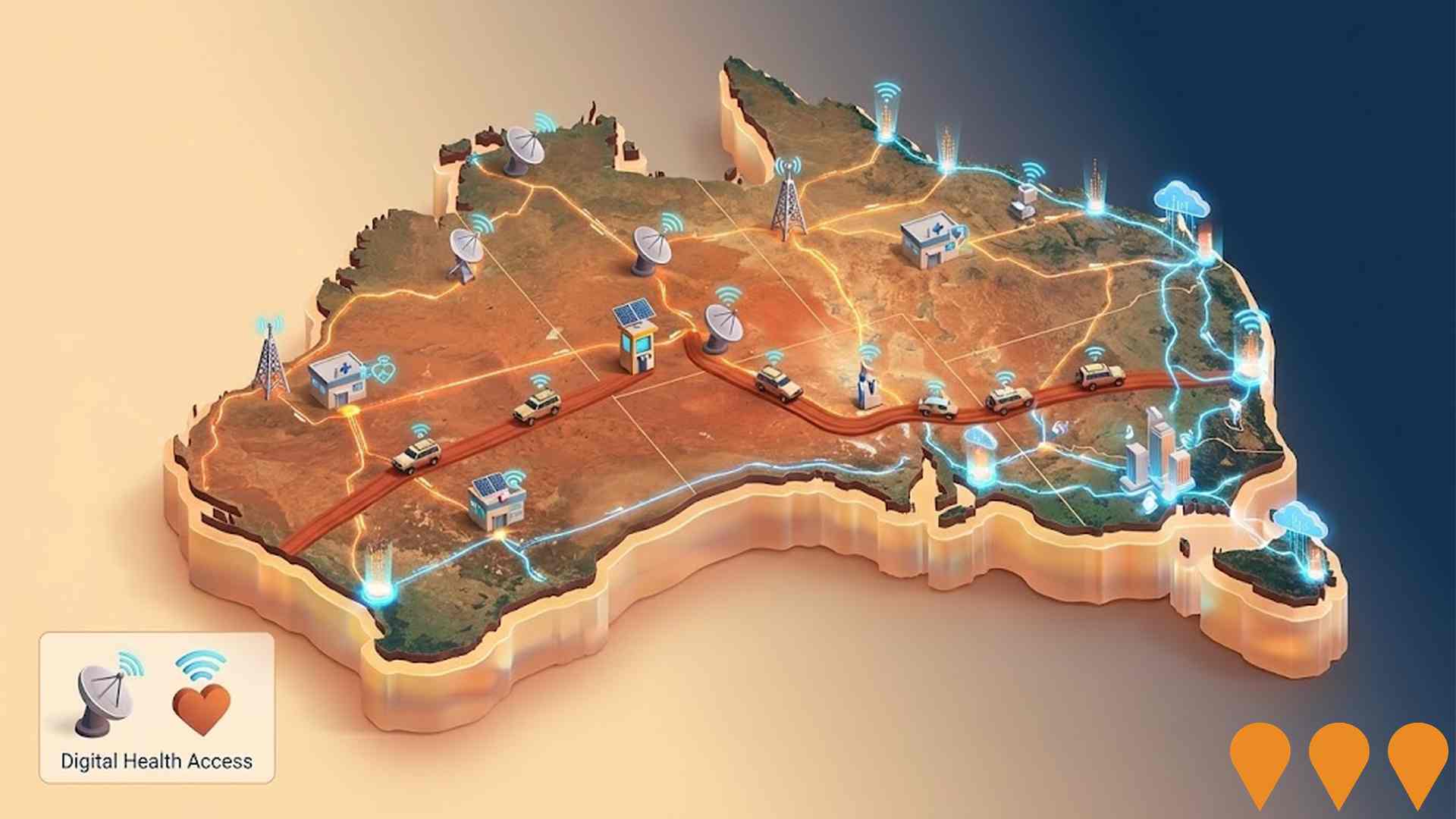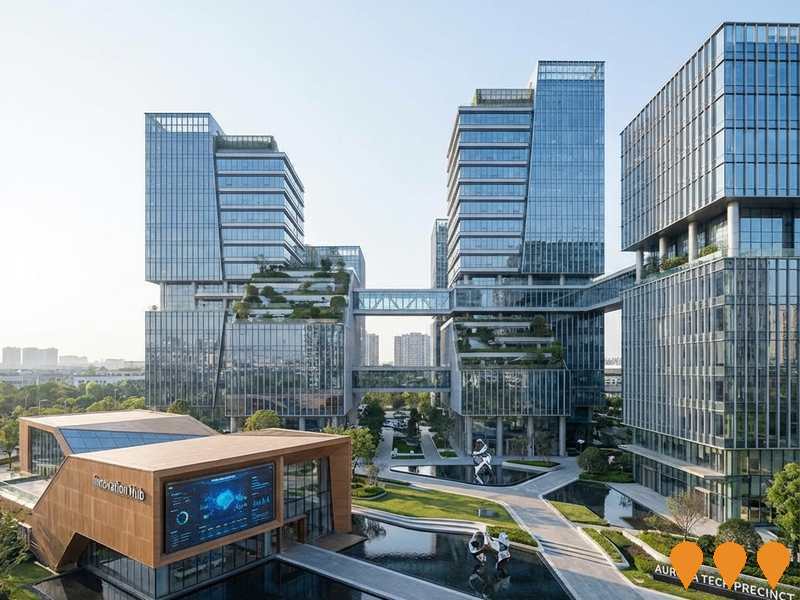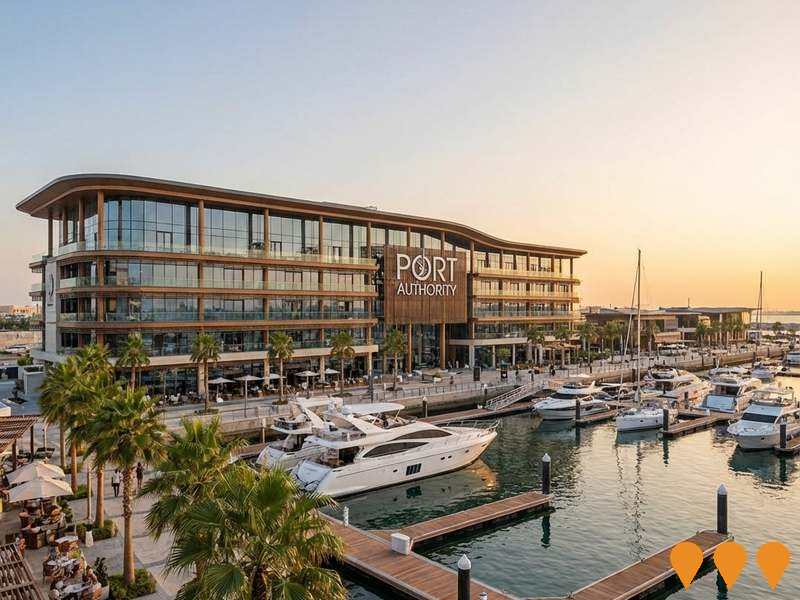Chart Color Schemes
est. as @ -- *
ABS ERP | -- people | --
2021 Census | -- people
Sales Activity
Curious about local property values? Filter the chart to assess the volume and appreciation (including resales) trends and regional comparisons, or scroll to the map below view this information at an individual property level.
Find a Recent Sale
Sales Detail
Population
An assessment of population growth drivers in Coconut Grove reveals an overall ranking slightly below national averages considering recent, and medium term trends
Coconut Grove's population, as per AreaSearch's analysis, stands at 3007 as of Aug 2025. This figure represents an increase of 115 people from the 2021 Census count of 2892 individuals, reflecting a growth rate of 4%. The change is inferred from ABS estimated resident population data for June 2024 and address validation since the Census date. This results in a population density of 2117 persons per square kilometer, exceeding the national average assessed by AreaSearch. Overseas migration contributed approximately 70.2% to recent population gains in the area.
AreaSearch utilizes ABS/Geoscience Australia projections for each SA2 area, released in 2024 with a base year of 2022. For areas not covered by this data and post-2032 growth estimates, AreaSearch applies age cohort-specific growth rates provided by the ABS in its latest Greater Capital Region projections (released in 2023, based on 2022 data). Looking ahead, above median population growth is projected for the area. By 2041, the population is expected to reach 3615 persons, marking a 20.2% increase over the 17-year period.
Frequently Asked Questions - Population
Development
The level of residential development activity in Coconut Grove is very low in comparison to the average area assessed nationally by AreaSearch
Coconut Grove has seen minimal dwelling approvals in recent years. Over the past five financial years ending June 2021, a total of one home was approved. As of August 2022, no dwelling approvals have been recorded for the current financial year, FY-26.
This is likely due to population decline and balanced supply and demand dynamics, offering buyers good choice. In terms of commercial development, $4.4 million in approvals were registered this financial year, indicating limited focus on commercial projects compared to residential ones. Compared to Greater Darwin, Coconut Grove has significantly less development activity, with building activity below average nationally. This scarcity of new homes typically strengthens demand and prices for existing properties. However, recent years have seen an acceleration in building activity, suggesting possible changes in planning constraints or increased demand.
Frequently Asked Questions - Development
Infrastructure
Coconut Grove has limited levels of nearby infrastructure activity, ranking in the 2ndth percentile nationally
Changes to local infrastructure significantly impact an area's performance. Two projects identified by AreaSearch are expected to influence this region. Key projects include Social Housing Accelerator Payment (SHAP) for Greater Darwin/Nightcliff, John Stokes Square Redevelopment, Darwin Mid Suburbs Area Plan, and Royal Darwin Hospital Mental Health Inpatient Unit and CSSD Upgrade. The following list details those most relevant.
Professional plan users can use the search below to filter and access additional projects.
INFRASTRUCTURE SEARCH
 Denotes AI-based impression for illustrative purposes only, not to be taken as definitive under any circumstances. Please follow links and conduct other investigations from the project's source for actual imagery. Developers and project owners wishing us to use original imagery please Contact Us and we will do so.
Denotes AI-based impression for illustrative purposes only, not to be taken as definitive under any circumstances. Please follow links and conduct other investigations from the project's source for actual imagery. Developers and project owners wishing us to use original imagery please Contact Us and we will do so.
Frequently Asked Questions - Infrastructure
Royal Darwin Hospital Mental Health Inpatient Unit and CSSD Upgrade
New three-storey mental health inpatient facility at Royal Darwin Hospital providing 18 acute inpatient beds plus a 6-bed Stabilisation Assessment and Referral Area (SARA), connected to the Emergency Department via an elevated enclosed walkway. Project also includes major upgrades to the Central Sterile Services Department (CSSD). Managing Contractor: Sitzler Pty Ltd. Works commenced in 2023 with practical completion expected mid-2025.

Australia-Asia PowerLink (AAPowerLink)
The world's largest renewable energy infrastructure project, comprising a 17-20GW solar farm and 36-42GWh battery storage in the Barkly Region, connected via HVDC transmission to Darwin and Singapore. The project received Commonwealth environmental approval in August 2024. It aims to supply up to 4GW of green electricity to Darwin industrial customers and export power to Singapore.

John Stokes Square Redevelopment
The John Stokes Square redevelopment in Nightcliff has transformed an aging public housing estate into a mixed use social housing and community precinct. Delivered by the Northern Territory Government, the project provides a new Nightcliff Police Station, 78 purpose built social housing units for seniors and people living with disability, improved public open space and landscaping, and a pedestrian friendly link between Nightcliff Village and Nightcliff Shopping Centre. Construction of the police station finished in 2021 and the social housing towers were completed in 2023, with tenants now moving in and community housing provider Venture Housing managing the complex.

Darwin Light Rail Stage 1
A proposed mass transit system, likely light rail or rapid bus, connecting Darwin CBD to Palmerston via the Stuart Highway corridor. The project aims to manage future population growth, reduce congestion, and improve connectivity between the two major population centres as part of the long-term Darwin Regional Transport Plan. While currently in the strategic planning phase with no immediate construction funding, the corridor has been identified for future preservation to support a '30-minute city' concept.

Enabling Digital Health Services for Regional and Remote Australia
National initiative to expand and improve digital health access for people in regional and remote Australia. Focus areas include enabling telehealth and virtual care, upgrading clinical systems and connectivity, supporting secure information exchange, and building workforce capability in digital health, aligned with the Australian Government's Digital Health Blueprint and Action Plan 2023-2033.

Desert Springs Octopus Renewable Energy Program
Majority Indigenous-owned developer pursuing a near-term pipeline of grid-connected solar and battery projects along the Darwin-Katherine Electricity System, with potential to expand into wind and green hydrogen. Partnership includes Octopus Australia with Larrakia Nation and Jawoyn Association to deliver utility-scale renewable energy and community benefit sharing.

Marine Industry Park
Marine and offshore industries servicing hub at East Arm, Darwin. Stage 1 planning approval is secured for a purpose-built industrial subdivision near the new Darwin Ship Lift, with expressions of interest open for serviced lots. Existing common-user facilities include an all-tide barge ramp (first point of entry) and a secure hardstand supporting storage and fabrication activities.

Hudson Creek Power Station
12MW natural gas-fired power plant, NT's first privately owned grid-connected gas generation facility. Features 25% lower emissions than average NT gas generators. Part of dual project with Batchelor Solar Farm, creating 162 construction jobs and providing vital grid stability to Darwin-Katherine network.

Employment
AreaSearch analysis reveals Coconut Grove recording weaker employment conditions than most comparable areas nationwide
Coconut Grove has an educated workforce with prominent representation in essential services sectors. Its unemployment rate was 5.8% as of June 2025.
Employment growth over the past year is estimated at 3.2%. As of June 2025, 1,723 residents are employed while the unemployment rate is 2.8% higher than Greater Darwin's rate of 3.0%. Workforce participation in Coconut Grove lags behind Greater Darwin, at 64.6% compared to 69.7%. Employment is concentrated in health care & social assistance, public administration & safety, and accommodation & food.
Health care & social assistance is particularly notable with employment levels at 1.5 times the regional average. However, public administration & safety is under-represented at 12.9% compared to Greater Darwin's 19.5%. Many residents may commute elsewhere for work based on Census data. Between June 2024 and June 2025, employment increased by 3.2% while labour force grew by 3.0%, reducing the unemployment rate by 0.2 percentage points. In contrast, Greater Darwin experienced employment growth of 2.9%. National employment forecasts from Jobs and Skills Australia, published in May 2025, project national employment growth of 6.6% over five years and 13.7% over ten years. Applying these projections to Coconut Grove's employment mix suggests local growth of approximately 6.9% over five years and 14.3% over ten years.
Frequently Asked Questions - Employment
Income
Income levels align closely with national averages, indicating typical economic conditions for Australian communities according to AreaSearch analysis
AreaSearch reports median taxpayer income in Coconut Grove was $54,745 and average income was $63,757 based on postcode level ATO data for financial year 2022. Nationally, median income was $65,522 and average was $75,260. By September 2025, estimated median income is approximately $61,320 and average is around $71,414, adjusted for Wage Price Index growth of 12.01%. Census data shows personal income ranked at the 69th percentile ($913 weekly) and household income at the 38th percentile. Major income segment comprises 31.9% earning $1,500-$2,999 weekly (959 residents). Housing affordability pressures are severe with only 82.5% of income remaining, ranking at the 37th percentile. SEIFA income ranking places Coconut Grove in the 5th decile.
Frequently Asked Questions - Income
Housing
Coconut Grove displays a diverse mix of dwelling types, with a higher proportion of rental properties than the broader region
In Coconut Grove, as per the latest Census data, 23.7% of dwellings were houses while 76.2% consisted of other types such as semi-detached homes, apartments, and 'other' dwellings. In comparison, Darwin metropolitan area had 68.4% houses and 31.6% other dwellings. Home ownership in Coconut Grove stood at 14.8%, with mortgaged dwellings at 22.7% and rented ones at 62.5%. The median monthly mortgage repayment was $1,600, lower than Darwin metro's average of $2,028. Median weekly rent in Coconut Grove was $300, compared to Darwin metro's $350. Nationally, Coconut Grove's mortgage repayments were significantly lower than the Australian average of $1,863, and rents were substantially below the national figure of $375.
Frequently Asked Questions - Housing
Household Composition
Coconut Grove features high concentrations of lone person households and group households, with a lower-than-average median household size
Family households constitute 56.2% of all households, including 21.5% couples with children, 23.6% couples without children, and 9.3% single parent families. Non-family households comprise the remaining 43.8%, with lone person households at 37.7% and group households making up 6.2%. The median household size is 2.2 people, which is smaller than the Greater Darwin average of 2.7.
Frequently Asked Questions - Households
Local Schools & Education
The educational profile of Coconut Grove exceeds national averages, with above-average qualification levels and academic performance metrics
Educational attainment in Coconut Grove is notably high. As of 2021, 40.7% of residents aged 15 and above hold university qualifications, compared to 27.3% in the Northern Territory (NT) and 30.4% nationally in Australia. Bachelor degrees are most common at 23.3%, followed by postgraduate qualifications at 14.0% and graduate diplomas at 3.4%. Vocational credentials are also prevalent, with 28.5% of residents holding such qualifications – advanced diplomas at 11.1% and certificates at 17.4%.
Educational participation is high, with 29.7% of residents currently enrolled in formal education as of the latest census data. This includes 9.9% in tertiary education, 6.7% in primary education, and 5.1% pursuing secondary education. However, educational facilities appear to be located outside Coconut Grove's immediate boundaries, requiring families to access schools in neighboring areas for their children's education.
Frequently Asked Questions - Education
Schools Detail
Nearby Services & Amenities
Transport
Transport servicing is high compared to other areas nationally based on assessment of service frequency, route connectivity and accessibility
Transport analysis indicates 13 operational stops within Coconut Grove, offering mixed bus services. These stops cater to 34 unique routes, facilitating a total of 2,127 weekly passenger trips. Transport accessibility is deemed excellent, with residents positioned an average of 170 meters from the nearest stop.
Service frequency averages 303 daily trips across all routes, translating to approximately 163 weekly trips per individual stop.
Frequently Asked Questions - Transport
Transport Stops Detail
Health
Coconut Grove's residents are extremely healthy with prevalence of common health conditions low among the general population though higher than the nation's average across older, at risk cohorts
Analysis shows strong health metrics throughout Coconut Grove, with low prevalence of common health conditions among its general population. However, this prevalence is higher than the national average among older, at-risk cohorts.
Private health cover rate is approximately 51% of the total population (~1,539 people), slightly lagging behind the average SA2 area's 56.7%. The most common medical conditions are mental health issues and arthritis, affecting 6.2 and 5.6% of residents respectively. 75.6% of residents declare themselves completely clear of medical ailments, compared to Greater Darwin's 77.0%. Coconut Grove has 14.7% of residents aged 65 and over (441 people), higher than Greater Darwin's 12.3%. Health outcomes among seniors require more attention than the broader population.
Frequently Asked Questions - Health
Cultural Diversity
Coconut Grove is among the most culturally diverse areas in the country based on AreaSearch assessment of a range of language and cultural background related metrics
Coconut Grove has a high level of cultural diversity, with 44.3% of its population speaking a language other than English at home and 46.5% born overseas. The dominant religion in Coconut Grove is Christianity, comprising 36.9% of the population. Hinduism is notably overrepresented, making up 12.9% of the population compared to the Greater Darwin average of 5.1%.
In terms of ancestry, the top three groups are Other at 23.3%, English at 16.9%, and Australian at 13.1%. Notably, Filipino is overrepresented at 5.2%, Australian Aboriginal at 8.6%, and Spanish at 0.8% compared to regional averages of 4.7%, 7.4%, and 0.5% respectively.
Frequently Asked Questions - Diversity
Age
Coconut Grove's population is younger than the national pattern
Coconut Grove's median age is 35 years, comparable to Greater Darwin's average of 34 and slightly lower than the national average of 38. Compared to Greater Darwin, Coconut Grove has a higher percentage of residents aged 25-34 (22.8%) but fewer residents aged 5-14 (7.7%). This concentration of 25-34 year-olds is significantly higher than the national average of 14.5%. Post-2021 Census data shows that the 75 to 84 age group has increased from 4.2% to 5.1% of the population, while the 25 to 34 cohort has decreased from 24.0% to 22.8%, and the 55 to 64 age group has dropped from 11.0% to 9.9%. Demographic projections suggest that Coconut Grove's age profile will change significantly by 2041, with the 45 to 54 cohort expected to grow by 41%, adding 128 residents to reach a total of 440. The 0 to 4 age group is projected to grow at a more modest rate of 4%, adding only 8 residents.





